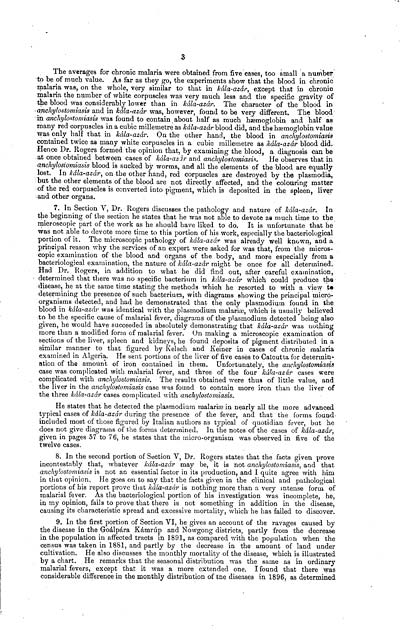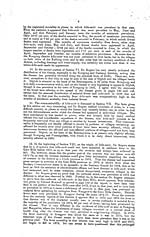Download files
Individual page:
Thumbnail gallery: Grid view | List view

3
The averages for chronic malaria were obtained from five cases, too small a number
to be of much value. As far as they go, the experiments show that the blood in chronic
malaria was, on the whole, very similar to that in kla-azr, except that in chronic
malaria the number of white corpuscles was very much less and the specific gravity of
the blood was considerably lower than in kla-azr. The character of the blood in
anchylostomiasis and in kla-azr was, however, found to be very different. The blood
in anchylostomiasis was found to contain about half as much hmoglobin and half as
many red corpuscles in a cubic millemetre as kla-azr blood did, and the hmoglobin value
was only half that in kla-azr. On the other hand, the blood in anchylostomiasis
contained twice as many white corpuscles in a cubic millemetre as kla-azr blood did.
Hence Dr. Rogers formed the opinion that, by examining the blood, a diagnosis can be
at once obtained between cases of kla-azr and anchylostomiasis. He observes that in
anchylosiomiasis blood is sucked by worms, and all the elements of the blood are equally
lost. In kla-azr, on the other hand, red corpuscles are destroyed by the plasmodia,
but the other elements of the blood are not directly affected, and the colouring matter
of the red corpuscles is converted into pigment, which is deposited in the spleen, liver
and other organs.
7. In Section V, Dr. Rogers discusses the pathology and nature of kla-azr. In
the beginning of the section he states that he was not able to devote as much time to the
microscopic part of the work as he should have liked to do. It is unfortunate that he
was not able to devote more time to this portion of his work, especially the bacteriological
portion of it. The microscopic pathology of kla-azr was already well known, and a
principal reason why the services of an expert were asked for was that, from the micros-
copic examination of the blood and organs of the body, and more especially from a
bacteriological examination, the nature of kla-azr might be once for all determined.
Had Dr. Rogers, in addition to what he did find out, after careful examination,
determined that there was no specific bacterium in kla-azr which could produce the
disease, he at the same time stating the methods which he resorted to with a view to
determining the presence of such bacterium, with diagrams showing the principal micro-
organisms detected, and had he demonstrated that the only plasmodium found in the
blood in kla-azr was identical with the plasmodium malari, which is usually believed
to be the specific cause of malarial fever, diagrams of the plasmodium detected being also
given, he would have succeeded in absolutely demonstrating that kla-azr was nothing
more than a modified form of malarial fever. On making a microscopic examination of
sections of the liver, spleen and kidneys, he found deposits of pigment distributed in a
similar manner to that figured by Kelsch and Keiner in cases of chronic malaria
examined in Algeria. He sent portions of the liver of five cases to Calcutta for determin-
ation of the amount of iron contained in them. Unfortunately, the anchylostomiasis
case was complicated with malarial fever, and three of the four kla-azr cases were
complicated with anchylostomiasis. The results obtained were thus of little value, and
the liver in the anchylostomiasis case was found to contain more iron than the liver of
the three kla-azr cases complicated with anchylostomiasis.
He states that he detected the plasmodium malari in nearly all the more advanced
typical cases of kla-azr during the presence of the fever, and that the forms found
included most of those figured by Italian authors as typical of quotidian fever, but he
does not give diagrams of the forms determined. In the notes of the cases of kla-azr,
given in pages 57 to 76, he states that the micro-organism was observed in five of the
twelve cases.
8. In the second portion of Section V, Dr. Rogers states that the facts given prove
incontestably that, whatever kla-azr may be, it is not anchylostomiasis, and that
anchylostomiasis is not an essential factor in its production, and I quite agree with him
in that opinion, He goes on to say that the facts given in the clinical and pathological
portions of his report prove that kla-azr is nothing more than a very intense form of
malarial fever. As the bacteriological portion of his investigation was incomplete, he,
in my opinion, fails to prove that there is not something in addition in the disease,
causing its characteristic spread and excessive mortality, which he has failed to discover.
9. In the first portion of Section VI, he gives an account of the ravages caused by
the disease in the Golpra Kmrp and Nowgong districts, partly from the decrease
in the population in affected tracts in 1891, as compared with the population when the
census was taken in 1881, and partly by the decrease in the amount of land under
cultivation. He also discusses the monthly mortality of the disease, which is illustrated
by a chart. He remarks that the seasonal distribution was the same as in ordinary
malarial fevers, except that it was a more extended one. I found that there was
considerable difference in the monthly distribution of the diseases in 1896, as determined
The averages for chronic malaria were obtained from five cases, too small a number
to be of much value. As far as they go, the experiments show that the blood in chronic
malaria was, on the whole, very similar to that in kla-azr, except that in chronic
malaria the number of white corpuscles was very much less and the specific gravity of
the blood was considerably lower than in kla-azr. The character of the blood in
anchylostomiasis and in kla-azr was, however, found to be very different. The blood
in anchylostomiasis was found to contain about half as much hmoglobin and half as
many red corpuscles in a cubic millemetre as kla-azr blood did, and the hmoglobin value
was only half that in kla-azr. On the other hand, the blood in anchylostomiasis
contained twice as many white corpuscles in a cubic millemetre as kla-azr blood did.
Hence Dr. Rogers formed the opinion that, by examining the blood, a diagnosis can be
at once obtained between cases of kla-azr and anchylostomiasis. He observes that in
anchylosiomiasis blood is sucked by worms, and all the elements of the blood are equally
lost. In kla-azr, on the other hand, red corpuscles are destroyed by the plasmodia,
but the other elements of the blood are not directly affected, and the colouring matter
of the red corpuscles is converted into pigment, which is deposited in the spleen, liver
and other organs.
7. In Section V, Dr. Rogers discusses the pathology and nature of kla-azr. In
the beginning of the section he states that he was not able to devote as much time to the
microscopic part of the work as he should have liked to do. It is unfortunate that he
was not able to devote more time to this portion of his work, especially the bacteriological
portion of it. The microscopic pathology of kla-azr was already well known, and a
principal reason why the services of an expert were asked for was that, from the micros-
copic examination of the blood and organs of the body, and more especially from a
bacteriological examination, the nature of kla-azr might be once for all determined.
Had Dr. Rogers, in addition to what he did find out, after careful examination,
determined that there was no specific bacterium in kla-azr which could produce the
disease, he at the same time stating the methods which he resorted to with a view to
determining the presence of such bacterium, with diagrams showing the principal micro-
organisms detected, and had he demonstrated that the only plasmodium found in the
blood in kla-azr was identical with the plasmodium malari, which is usually believed
to be the specific cause of malarial fever, diagrams of the plasmodium detected being also
given, he would have succeeded in absolutely demonstrating that kla-azr was nothing
more than a modified form of malarial fever. On making a microscopic examination of
sections of the liver, spleen and kidneys, he found deposits of pigment distributed in a
similar manner to that figured by Kelsch and Keiner in cases of chronic malaria
examined in Algeria. He sent portions of the liver of five cases to Calcutta for determin-
ation of the amount of iron contained in them. Unfortunately, the anchylostomiasis
case was complicated with malarial fever, and three of the four kla-azr cases were
complicated with anchylostomiasis. The results obtained were thus of little value, and
the liver in the anchylostomiasis case was found to contain more iron than the liver of
the three kla-azr cases complicated with anchylostomiasis.
He states that he detected the plasmodium malari in nearly all the more advanced
typical cases of kla-azr during the presence of the fever, and that the forms found
included most of those figured by Italian authors as typical of quotidian fever, but he
does not give diagrams of the forms determined. In the notes of the cases of kla-azr,
given in pages 57 to 76, he states that the micro-organism was observed in five of the
twelve cases.
8. In the second portion of Section V, Dr. Rogers states that the facts given prove
incontestably that, whatever kla-azr may be, it is not anchylostomiasis, and that
anchylostomiasis is not an essential factor in its production, and I quite agree with him
in that opinion, He goes on to say that the facts given in the clinical and pathological
portions of his report prove that kla-azr is nothing more than a very intense form of
malarial fever. As the bacteriological portion of his investigation was incomplete, he,
in my opinion, fails to prove that there is not something in addition in the disease,
causing its characteristic spread and excessive mortality, which he has failed to discover.
9. In the first portion of Section VI, he gives an account of the ravages caused by
the disease in the Golpra Kmrp and Nowgong districts, partly from the decrease
in the population in affected tracts in 1891, as compared with the population when the
census was taken in 1881, and partly by the decrease in the amount of land under
cultivation. He also discusses the monthly mortality of the disease, which is illustrated
by a chart. He remarks that the seasonal distribution was the same as in ordinary
malarial fevers, except that it was a more extended one. I found that there was
considerable difference in the monthly distribution of the diseases in 1896, as determined
Set display mode to: Large image | Zoom image | Transcription
Images and transcriptions on this page, including medium image downloads, may be used under the Creative Commons Attribution 4.0 International Licence unless otherwise stated. ![]()
| India Papers > Medicine - Disease > Resolution on Dr Rogers' report on Kala azar. > (10) Page 3 |
|---|
| Permanent URL | https://digital.nls.uk/74581350 |
|---|




